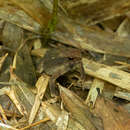pt-BR
nomes no trilho de navegação


The lesser toad, or dwarf stream toad, Ingerophrynus parvus, is occurs widely at lowland altitudes up to 550 m asl across western and Peninsular Thailand, Peninsular Malaysia, southern Myanmar, Indonesia and isolated populations in southeastern Thailand and in Cambodia (IUCN SSC Amphibian Specialist Group 2014; Vörös et al. 2012).Although uncommon in Indonesia, it is abundant elsewhere within its range.Its primary habitat is swampy areas near streams in coastal vegetation and lowland rainforest. It can jump well, and climbs up into vegetation in addition to the forest floor. It is generally not found in cleared areas, but does occur in rubber plantations and gardens (IUCN SSC Amphibian Specialist Group 2014; Halliday 2016).
The stocky, tiny adult I. parvus toads can be brown, black, or reddish in color with pale belly, while the juveniles are bronze-brown in color, sometimes with a pink snout. Their wrinkly dorsal skin is covered with small warts.They have only partially webbed toes. Adults have a pair of symmetrical black spots on the mid-back, and ridges on their head. Males usually have a reddish throat (Iskandar, 1998). Females are somewhat larger (snout vent length 40-50 mm) than males (30-35 mm). The species name, parvus, come from the Latin word for small (IUCN SSC Amphibian Specialist Group 2014).
Shahriza et al. (2012) described the reproductive behavior of Ingerophrynus parvus in Malaysia.Tadpoles are not adapted for high-flow water, and these toads breed in low-flow pools and ephemeral puddles that occur in rainy seasons. Males call every month, but peak calling/breeding coincides with the onset of rains (July-August) when males congregate in large numbers.Females spawn clutches of eggs directly into the water source. The tadpoles are also small in size.
These toads have toxic skin.Skin extracts from 100 mg of skin cause locomotor issues, convulsions, and death to mice within 2 hours. The active toxic constituents isolated are bufadienolides; research has not yet identified the exact compound in this species. Unlike other bufonid toads, skin extracts from I. parvus did not contain serotonin products (Daly et al. 2004).
Though for years New World frogs have been plagued with deadly chytridiomycosis, incidence in Asian frogs is poorly knonw.The first case of Batrachochytrium dendrobatidis infection in Malaysia was reported in one individual Ingerophrynus parvus in 2011.The individual did not show signs of disease and this fungus has not shown signs of decimating the population or other species in the area (Vörös et al. 2012).
The skin of Ingerophrynus parvus, like most bufonid frogs, is toxic.Although skin of frogs of genus Bufo (I. parvus is formerly considered part of the Bufo group) usually contain indolic amines, such as serotonin, Daly et al. (2004), found no serotonin or its methylated products in analysis of skin extract of 18 Malaysian bufonic frogs, nor evidence of lipophilic alkaloids indicating they do not sequester dietary alkaloids from invertebrates they eat.The results of Daly et al. (2004) indicate that the skin of I. parvus containes bufadienolides (unclassified).These are neutral lipophilic compounds with an unusual C17 steroidal nucleus contining an α-pyrone ring and cis-fused rings with 3β, 14β hydroxyl groups; they also often have additional oxygenation, such as epoxide, ketone, acetoxyl or more hydroxyl groups (Daly et al. 2004; Daly et al. 2008).